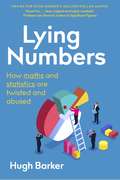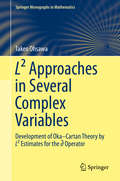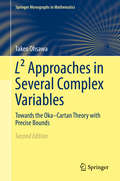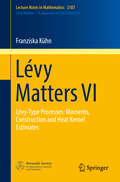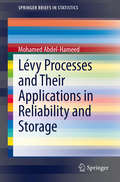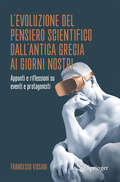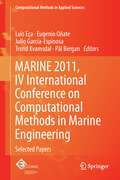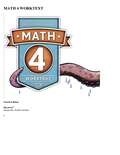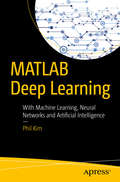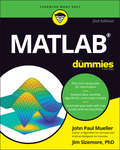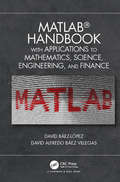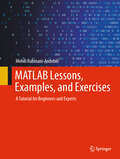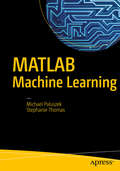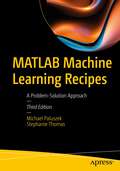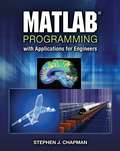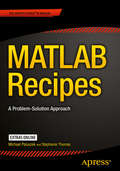- Table View
- List View
Lyapunov-type Inequalities
by Juan Pablo PinascoThe eigenvalue problems for quasilinear and nonlinear operators present many differences with the linear case, and a Lyapunov inequality for quasilinear resonant systems showed the existence of eigenvalue asymptotics driven by the coupling of the equations instead of the order of the equations. For p=2, the coupling and the order of the equations are the same, so this cannot happen in linear problems. Another striking difference between linear and quasilinear second order differential operators is the existence of Lyapunov-type inequalities in R^n when p>n. Since the linear case corresponds to p=2, for the usual Laplacian there exists a Lyapunov inequality only for one-dimensional problems. For linear higher order problems, several Lyapunov-type inequalities were found by Egorov and Kondratiev and collected in On spectral theory of elliptic operators, Birkhauser Basel 1996. However, there exists an interesting interplay between the dimension of the underlying space, the order of the differential operator, the Sobolev space where the operator is defined, and the norm of the weight appearing in the inequality which is not fully developed. Also, the Lyapunov inequality for differential equations in Orlicz spaces can be used to develop an oscillation theory, bypassing the classical sturmian theory which is not known yet for those equations. For more general operators, like the p(x) laplacian, the possibility of existence of Lyapunov-type inequalities remains unexplored.
Lying Numbers: How Maths and Statistics Are Twisted and Abused
by Hugh BarkerA readily understandable exploration of how figures are badly reported or deliberately misrepresented everywhere from political arguments and briefings to business presentations and shopping offers.Praise for Hugh Barker's Million Dollar Maths:'Great fun. A clear, original and highly readable account of the curious relationship between mathematics and money.' Professor Ian Stewart - author of Significant Figures'A lively crash course in the mathematics of gambling, investing, and managing. Hugh Barker makes deep ideas fun and profitable.' William Poundstone - author of How to Predict the UnpredictablePoliticians, economists, scientists, journalists . . . all of them have been known to bend the truth and to twist the facts from time to time. But surely the numbers and statistics they rely on are cold, hard objective facts that tell the real story? Of course the truth is much murkier than that. Figures can be misinterpreted, misunderstood, misconstrued and misused in hundreds of different ways. This book takes a look at the many ways that statistical information can be badly reported or deliberately misused in all walks of life, from political arguments, to business presentations, to more local concerns such as shopping offers and utility bills. A polemical guide to how numbers are used to mislead, which is intended to help the reader through the minefield of dubious stats and lying numbers.
Lying Numbers: How Maths and Statistics Are Twisted and Abused
by Pocket Book of R Hugh BarkerA readily understandable exploration of how figures are badly reported or deliberately misrepresented everywhere from political arguments and briefings to business presentations and shopping offers.Praise for Hugh Barker's Million Dollar Maths:'Great fun. A clear, original and highly readable account of the curious relationship between mathematics and money.' Professor Ian Stewart - author of Significant Figures'A lively crash course in the mathematics of gambling, investing, and managing. Hugh Barker makes deep ideas fun and profitable.' William Poundstone - author of How to Predict the Unpredictable Politicians, economists, scientists, journalists . . . all of them have been known to bend the truth and to twist the facts from time to time. But surely the numbers and statistics they rely on are cold, hard objective facts that tell the real story? Of course the truth is much murkier than that. Figures can be misinterpreted, misunderstood, misconstrued and misused in hundreds of different ways. This book takes a look at the many ways that statistical information can be badly reported or deliberately misused in all walks of life, from political arguments, to business presentations, to more local concerns such as shopping offers and utility bills. A polemical guide to how numbers are used to mislead, which is intended to help the reader through the minefield of dubious stats and lying numbers.
L² Approaches in Several Complex Variables
by Takeo OhsawaThe purpose of this monograph is to present the current status of a rapidly developing part of several complex variables, motivated by the applicability of effective results to algebraic geometry and differential geometry. Highlighted are the new precise results on the L² extension of holomorphic functions. In Chapter 1, the classical questions of several complex variables motivating the development of this field are reviewed after necessary preparations from the basic notions of those variables and of complex manifolds such as holomorphic functions, pseudoconvexity, differential forms, and cohomology. In Chapter 2, the L² method of solving the d-bar equation is presented emphasizing its differential geometric aspect. In Chapter 3, a refinement of the Oka-Cartan theory is given by this method. The L² extension theorem with an optimal constant is included, obtained recently by Z. BÅ,ocki and by Q. -A. Guan and X. -Y. Zhou separately. In Chapter 4, various results on the Bergman kernel are presented, including recent works of Maitani-Yamaguchi, Berndtsson, and Guan-Zhou. Most of these results are obtained by the L² method. In the last chapter, rather specific results are discussed on the existence and classification of certain holomorphic foliations and Levi flat hypersurfaces as their stables sets. These are also applications of the L² method obtained during these 15 years.
L² Approaches in Several Complex Variables: Towards the Oka–Cartan Theory with Precise Bounds (Springer Monographs in Mathematics)
by Takeo OhsawaThis monograph presents the current status of a rapidly developing part of several complex variables, motivated by the applicability of effective results to algebraic geometry and differential geometry. Special emphasis is put on the new precise results on the L² extension of holomorphic functions in the past 5 years.In Chapter 1, the classical questions of several complex variables motivating the development of this field are reviewed after necessary preparations from the basic notions of those variables and of complex manifolds such as holomorphic functions, pseudoconvexity, differential forms, and cohomology. In Chapter 2, the L² method of solving the d-bar equation is presented emphasizing its differential geometric aspect. In Chapter 3, a refinement of the Oka–Cartan theory is given by this method. The L² extension theorem with an optimal constant is included, obtained recently by Z. Błocki and separately by Q.-A. Guan and X.-Y. Zhou. In Chapter 4, various results on the Bergman kernel are presented, including recent works of Maitani–Yamaguchi, Berndtsson, Guan–Zhou, and Berndtsson–Lempert. Most of these results are obtained by the L² method. In the last chapter, rather specific results are discussed on the existence and classification of certain holomorphic foliations and Levi flat hypersurfaces as their stables sets. These are also applications of the L² method obtained during the past 15 years.
Lévy Matters II
by Victor Rivero Alexey Kuznetsov Serge Cohen Andreas KyprianouThis is the second volume in a subseries of the Lecture Notes in Mathematics called Lévy Matters, which is published at irregular intervals over the years. Each volume examines a number of key topics in the theory or applications of Lévy processes and pays tribute to the state of the art of this rapidly evolving subject with special emphasis on the non-Brownian world. The expository articles in this second volume cover two important topics in the area of Lévy processes. The first article by Serge Cohen reviews the most important findings on fractional Lévy fields to date in a self-contained piece, offering a theoretical introduction as well as possible applications and simulation techniques. The second article, by Alexey Kuznetsov, Andreas E. Kyprianou, and Victor Rivero, presents an up to date account of the theory and application of scale functions for spectrally negative Lévy processes, including an extensive numerical overview.
Lévy Matters V
by Makoto Maejima Lars Nørvang Andersen Søren Asmussen Frank Aurzada Peter W. Glynn Mats Pihlsgård Thomas SimonThis three-chapter volume concerns the distributions of certain functionals of Lévy processes. The first chapter, by Makoto Maejima, surveys representations of the main sub-classes of infinitesimal distributions in terms of mappings of certain Lévy processes via stochastic integration. The second chapter, by Lars Nørvang Andersen, Søren Asmussen, Peter W. Glynn and Mats Pihlsgård, concerns Lévy processes reflected at two barriers, where reflection is formulated à la Skorokhod. These processes can be used to model systems with a finite capacity, which is crucial in many real life situations, a most important quantity being the overflow or the loss occurring at the upper barrier. If a process is killed when crossing the boundary, a natural question concerns its lifetime. Deep formulas from fluctuation theory are the key to many classical results, which are reviewed in the third chapter by Frank Aurzada and Thomas Simon. The main part, however, discusses recent advances and developments in the setting where the process is given either by the partial sum of a random walk or the integral of a Lévy process.
Lévy Matters VI
by Franziska KühnPresenting some recent results on the construction and the moments of Lévy-type processes, the focus of this volume is on a new existence theorem, which is proved using a parametrix construction. Applications range from heat kernel estimates for a class of Lévy-type processes to existence and uniqueness theorems for Lévy-driven stochastic differential equations with Hölder continuous coefficients. Moreover, necessary and sufficient conditions for the existence of moments of Lévy-type processes are studied and some estimates on moments are derived. Lévy-type processes behave locally like Lévy processes but, in contrast to Lévy processes, they are not homogeneous in space. Typical examples are processes with varying index of stability and solutions of Lévy-driven stochastic differential equations.This is the sixth volume in a subseries of the Lecture Notes in Mathematics called Lévy Matters. Each volume describes a number of important topics in the theory or applications of Lévy processes and pays tribute to the state of the art of this rapidly evolving subject, with special emphasis on the non-Brownian world.
Lévy Processes and Their Applications in Reliability and Storage
by Mohamed Abdel-HameedThis book covers Lévy processes and their applications in the contexts of reliability and storage. Special attention is paid to life distributions and the maintenance of devices subject to degradation; estimating the parameters of the degradation process is also discussed, as is the maintenance of dams subject to Lévy input.
Lösungsverhalten gewöhnlicher Riccati-Gleichungen (essentials)
by Reiner ThieleDas Buch vermittelt zielführende Algorithmen zur Lösung gewöhnlicher Riccati-Differenzialgleichungen (DGL). Man verwendet sie zum Design potenzialgetrennter Faraday-Effekt-Stromsensoren. Neu ist die Applikation von Partiallösungen, wobei man sich eine erste Teillösung vorgibt und eine zweite passend zur ersten bestimmt. Außerdem kreiert Reiner Thiele analoge Netzwerke zur Signalverarbeitung sowie Simulationsdiagramme für diese DGL und erläutert, dass es sich bei der Hardware um spezielle Regelkreise handelt.
Lösungsverhalten partieller Riccati-Gleichungen (essentials)
by Reiner ThieleDas Buch vermittelt Lösungsverfahren für partielle Riccati-Differenzialgleichungen (DGL). Diese DGL appliziert man zur mathematischen Beschreibung der Funktion von Faraday-Effekt-Stromsensoren. Ausgehend vom allgemeinen Lösungsverhalten erfolgt die Definition des individuellen sowie kollektiven Lösungsverhaltens einer beliebigen Gleichung. Reiner Thiele erklärt den Unterschied zwischen Individual- und Partiallösungen. Außerdem kreiert er Simulationsdiagramme und zeigt, dass es sich bei der Hardware um Regelkreise handelt.
L’evoluzione del pensiero scientifico dall’antica Grecia ai giorni nostri: Appunti e riflessioni su eventi e protagonisti
by Francesco VissaniLa scienza, come ogni cosa al mondo, ha avuto un inizio, un'origine. Sebbene non si possa stabilire con precisione il momento esatto degli esordi, il contributo della civiltà greca, come ampiamente attestato dai documenti, è stato cruciale; molti, tra cui l’autore, lo considerano essenziale per la nascita della scienza come la conosciamo. Il libro esplora l'evoluzione del pensiero scientifico con una raccolta di appunti e saggi che, procedendo in ordine cronologico ma senza seguire una struttura rigida, mantiene la lettura istruttiva e interessante. Si esaminano le prime forme assunte dalla scienza, la fioritura dell'ellenismo, la sua crisi e la sua rinascita, con particolare attenzione ai rapporti con la filosofia. Il viaggio inizia con i presocratici e i pitagorici, concentrandosi su Democrito, Platone e Archimede, e continua con un breve passaggio nell'era romana. Continua con il periodo arabo, per passare al Medioevo, con un riferimento a Dante; giunge infine al Rinascimento e ai pensatori moderni tra cui Galilei. Nell'ultima parte viene presentata la storia di alcune delle grandi scoperte della fisica, evidenziandone le relazioni con il pensiero antico; si conclude ragionando di situazioni contemporanee.
M8.0 Wenchuan Earthquake
by Huilin Xing Xiwei XuThe M8.0 Wenchuan Earthquake occurred in China on May 12, 2008, killing over 69,000 people and displacing millions from their homes. This was one of the most catastrophic natural disasters on record. This book includes 5 chapters describing the tectonic setting and historical earthquakes around the Chuan-Dian region, the nucleation of the Wenchuan earthquake, occurrence and aftershocks. The field observations of earthquake induced surface fractures and building damage, form a major and special part of this book and include a large number of digital photos with accompanying explanantions.
MARINE 2011, IV International Conference on Computational Methods in Marine Engineering
by Eugenio Oñate Julio García-Espinosa Luís Eça Pål Bergan Trond KvamsdalThis book contains selected papers from the Fourth International Conference on Computational Methods in Marine Engineering, held at Instituto Superior Técnico, Technical University of Lisbon, Portugal in September 2011. Nowadays, computational methods are an essential tool of engineering, which includes a major field of interest in marine applications, such as the maritime and offshore industries and engineering challenges related to the marine environment and renewable energies. The 2011 Conference included 8 invited plenary lectures and 86 presentations distributed through 10 thematic sessions that covered many of the most relevant topics of marine engineering today. This book contains 16 selected papers from the Conference that cover "CFD for Offshore Applications", "Fluid-Structure Interaction", "Isogeometric Methods for Marine Engineering", "Marine/Offshore Renewable Energy", "Maneuvering and Seakeeping", "Propulsion and Cavitation" and "Ship Hydrodynamics". The papers were selected with the help of the recognized experts that collaborated in the organization of the thematic sessions of the Conference, which guarantees the high quality of the papers included in this book.
MATH 4 WORKTEXT
by Dickinson Lindsey MEdBJU Press' Math 4 Worktext, 4th ed. develops problem solving skills and teaches students to work out math problems accurately. Each math concept is demonstrated in clear examples before students attempt the exercise problems. Students will gain mastery of multiplication, division, fractions, and geometry. Each chapter concludes with a chapter review and cumulative review to help students retain these math concepts.
MATLAB Deep Learning
by Phil KimThis book consists of six chapters, which can be grouped into three subjects. The first subject is Machine Learning and takes place in Chapter 1. Deep Learning stems from Machine Learning. This implies that if you want to understand the essence of Deep Learning, you have to know the philosophy behind Machine Learning to some extent. Chapter 1 starts with the relationship between Machine Learning and Deep Learning, followed by problem solving strategies and fundamental limitations of Machine Learning. The detailed techniques are not introduced yet. Instead, fundamental concepts that applies to both the neural network and Deep Learning will be covered. The second subject is artificial neural network. Chapters 2-4 focuses on this subject. As Deep Learning is a type of Machine Learning that employs a neural network, the neural network is inseparable from Deep Learning. Chapter 2 starts with the fundamentals of the neural network: principles of its operation, architecture, and learning rules. It also provides the reason that the simple single-layer architecture evolved to the complex multi-layer architecture. Chapter 3 presents the backpropagation algorithm, which is an important and representative learning rule of the neural network and also employed in Deep Learning. This chapter explains how cost functions and learning rules are related and which cost functions are widely employed in Deep Learning. Chapter 4 introduces how to apply the neural network to classification problems. We have allocated a separate section for classification because it is currently the most prevailing application of Machine Learning. For example, image recognition, one of the primary applications of Deep Learning, is a classification problem. The third topic is Deep Learning. It is the main topic of this book as well. Deep Learning is covered in Chapters 5 and 6. Chapter 5 introduces the drivers that enables Deep Learning to yield excellent performance. For a better understanding, it starts with the history of barriers and solutions of Deep Learning. Chapter 6 covers the convolution neural network, which is representative of Deep Learning techniques. The convolution neural network is second-to-none in terms of image recognition. This chapter starts with an introduction of the basic concept and architecture of the convolution neural network as it compares with the previous image recognition algorithms. It is followed by an explanation of the roles and operations of the convolution layer and pooling layer, which act as essential components of the convolution neural network. The chapter concludes with an example of digit image recognition using the convolution neural network and investigates the evolution of the image throughout the layers.
MATLAB For Dummies
by John Paul Mueller Jim SizemoreGo from total MATLAB newbie to plotting graphs and solving equations in a flash! MATLAB is one of the most powerful and commonly used tools in the STEM field. But did you know it doesn’t take an advanced degree or a ton of computer experience to learn it? MATLAB For Dummies is the roadmap you’ve been looking for to simplify and explain this feature-filled tool. This handy reference walks you through every step of the way as you learn the MATLAB language and environment inside-and-out. Starting with straightforward basics before moving on to more advanced material like Live Functions and Live Scripts, this easy-to-read guide shows you how to make your way around MATLAB with screenshots and newly updated procedures. It includes: A comprehensive introduction to installing MATLAB, using its interface, and creating and saving your first file Fully updated to include the 2020 and 2021 updates to MATLAB, with all-new screenshots and up-to-date procedures Enhanced debugging procedures and use of the Symbolic Math Toolbox Brand new instruction on working with Live Scripts and Live Functions, designing classes, creating apps, and building projects Intuitive walkthroughs for MATLAB’s advanced features, including importing and exporting data and publishing your work Perfect for STEM students and new professionals ready to master one of the most powerful tools in the fields of engineering, mathematics, and computing, MATLAB For Dummies is the simplest way to go from complete newbie to power user faster than you would have thought possible.
MATLAB Handbook with Applications to Mathematics, Science, Engineering, and Finance
by Jose Miguel David Baez-Lopez David Alfredo Baez VillegasThe purpose of this handbook is to allow users to learn and master the mathematics software package MATLAB®, as well as to serve as a quick reference to some of the most used instructions in the package. A unique feature of this handbook is that it can be used by the novice and by experienced users alike. For experienced users, it has four chapters with examples and applications in engineering, finance, physics, and optimization. Exercises are included, along with solutions available for the interested reader on the book’s web page. These exercises are a complement for the interested reader who wishes to get a deeper understanding of MATLAB. <P><P>Features <P><P>Covers both MATLAB and introduction to Simulink <P><P>Covers the use of GUIs in MATLAB and Simulink <P><P>Offers downloadable examples and programs from the handbook’s website <P><P>Provides an introduction to object oriented programming using MATLAB <P><P>Includes applications from many areas <P><P>Includes the realization of executable files for MATLAB programs and Simulink models
MATLAB Lessons, Examples, and Exercises: A Tutorial for Beginners and Experts
by Mehdi Rahmani-AndebiliMATLAB Lessons, Examples, and Exercises: A Tutorial for Beginners and Experts is a book for anyone interested in learning MATLAB, a popular programming language used in mathematics, engineering, and science. Whether you’re a student, instructor, engineer, or technical professional, this book provides easy-to-follow lessons, examples, and exercises in each section of every chapter, emphasizing writing and executing code to help you become proficient in programming with MATLAB. Different colors make the code, outputs, and program descriptions more straightforward to read to improve reader comprehension. The book covers all the essential functions of MATLAB that are needed in math, engineering, and science, and it explains the math behind each function so you can apply them to solve real-world problems. Whether you’re new to programming or an expert, this book offers clear explanations, diverse examples, and hands-on exercises to help you improve your MATLAB programming skills and understand how to use MATLAB in various fields.
MATLAB Machine Learning
by Stephanie Thomas Michael PaluszekThis book is a comprehensive guide to machine learning with worked examples in MATLAB. It starts with an overview of the history of Artificial Intelligence and automatic control and how the field of machine learning grew from these. It provides descriptions of all major areas in machine learning. The book reviews commercially available packages for machine learning and shows how they fit into the field. The book then shows how MATLAB can be used to solve machine learning problems and how MATLAB graphics can enhance the programmer's understanding of the results and help users of their software grasp the results. Machine Learning can be very mathematical. The mathematics for each area is introduced in a clear and concise form so that even casual readers can understand the math. Readers from all areas of engineering will see connections to what they know and will learn new technology. The book then provides complete solutions in MATLAB for several important problems in machine learning including face identification, autonomous driving, and data classification. Full source code is provided for all of the examples and applications in the book. What you'll learn: An overview of the field of machine learning Commercial and open source packages in MATLAB How to use MATLAB for programming and building machine learning applications MATLAB graphics for machine learning Practical real world examples in MATLAB for major applications of machine learning in big data Who is this book for: The primary audiences are engineers and engineering students wanting a comprehensive and practical introduction to machine learning.
MATLAB Machine Learning Recipes: A Problem-Solution Approach
by Stephanie Thomas Michael PaluszekHarness the power of MATLAB to resolve a wide range of machine learning challenges. This new and updated third edition provides examples of technologies critical to machine learning. Each example solves a real-world problem, and all code provided is executable. You can easily look up a particular problem and follow the steps in the solution.This book has something for everyone interested in machine learning. It also has material that will allow those with an interest in other technology areas to see how machine learning and MATLAB can help them solve problems in their areas of expertise. The chapter on data representation and MATLAB graphics includes new data types and additional graphics. Chapters on fuzzy logic, simple neural nets, and autonomous driving have new examples added. And there is a new chapter on spacecraft attitude determination using neural nets. Authors Michael Paluszek and Stephanie Thomas show how all of these technologies allow you to build sophisticated applications to solve problems with pattern recognition, autonomous driving, expert systems, and much more.What You Will LearnWrite code for machine learning, adaptive control, and estimation using MATLABUse MATLAB graphics and visualization tools for machine learningBecome familiar with neural netsBuild expert systemsUnderstand adaptive controlGain knowledge of Kalman FiltersWho This Book Is ForSoftware engineers, control engineers, university faculty, undergraduate and graduate students, hobbyists.
MATLAB Primer
by Timothy A. DavisHighlighting the new aspects of MATLAB 7.10 and expanding on many existing features, this eighth edition continues to offer a hands-on, step-by-step introduction to using the powerful tools of MATLAB. It includes a new chapter on object-oriented programming, a new discussion of the MATLAB File Exchange window, major changes to the MATLAB Editor, and an explanation of more powerful Help tools. It also presents a synopsis of the most frequently used functions, operators, and special characters-providing quick and easy access to frequently used information. M-files and MEX-files for large examples are available at www.crcpress.com
MATLAB Programming with Applications for Engineers
by Stephen J. ChapmanThis textbook seeks to simultaneously teach MATLAB as a technical programming language while introducing the student to many of the practical functions that make solving problems in MATLAB so much easier than in other languages. It provides a complete introduction to the fundamentals of good procedural programming and aids students in developing good design habits that will serve them well in any other language that they may pick up later.
MATLAB Recipes
by Stephanie Thomas Michael PaluszekLearn from state-of-the-art examples in robotics, motors, detection filters, chemical processes, aircraft, and spacecraft. MATLAB Recipes: A Problem-Solution Approach is a practical reference for industry engineers using MATLAB to solve everyday problems. With this book you will review contemporary MATLAB coding including the latest language features and use MATLAB as a software development environment including code organization, GUI development, and algorithm design and testing. This book provides practical guidance for using MATLAB to build a body of code you can turn to time and again for solving technical problems in your line of work. Develop algorithms, test them, visualize the results, and pass the code along to others to create a functional code base for your firm. What you'll learn Learn how to build industrial-strength toolboxes Move beyond a folder of scripts and create well-organized, reusable MATLAB code modules Leverage MATLAB as an IDE and not just a programming language Build a functional code base for your company or department Create your own GUIs for repeatable workflows Who this book is for This book is written for engineers and scientists who use MATLAB on a regular basis and who want to take their coding to a higher level, i. e. people who want to make commercial-quality MATLAB toolboxes. This book may be used by students who are required to use MATLAB for their courses and projects as well as professionals who use MATLAB to solve problems on the job. Table of Contents Part I: Coding in MATLAB 1. Coding Basics 2. MATLAB Style 3. Visualization 4. Interactive Graphics 5. Testing and Debugging Part II: Applications 6. The Double Integrator 7. Robotics 8. Electrical Motor 9. Fault Detection 10. Chemical Processes 11. Aircraft 12. Spacecraft

